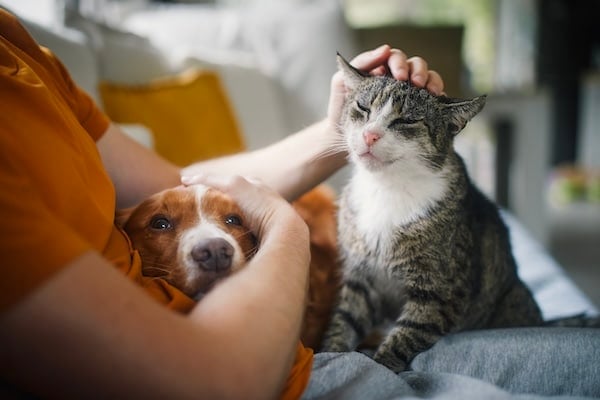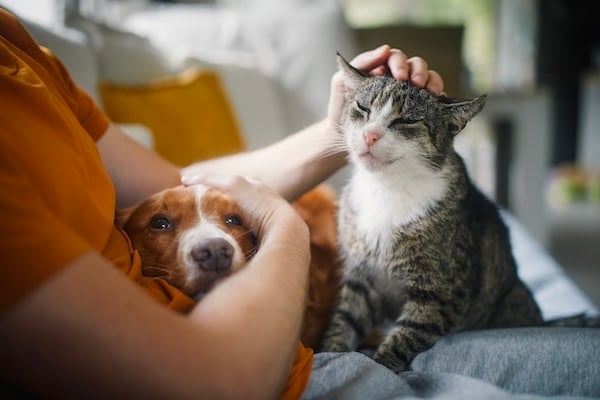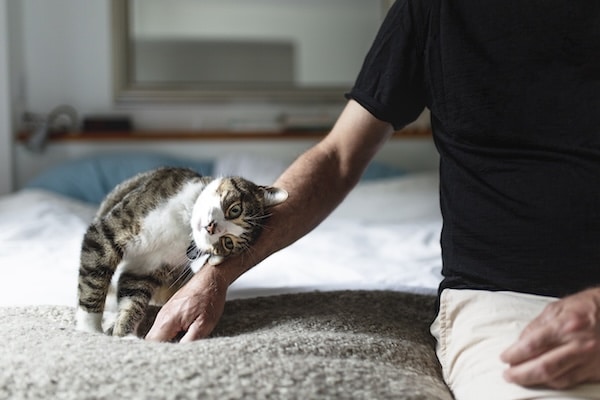
Check out our latest products
Whether you’re traveling for business or vacation, hiring a sitter to stay in your home can offer peace of mind that your pet is being cared for on their own turf. But before you can rest easy with that knowledge, you have to find the right person who ticks all the boxes and prep your home for their stay.
Navigating the journey of securing a trustworthy pet sitter can be daunting, especially if you’re doing it for the first time. What’s okay to ask in the vetting process? When should the sitter meet your pet? Can they help with additional chores during their stay? Or does this go against normal house-sitting etiquette?
If you’re feeling overwhelmed with everything you should and shouldn’t do when setting up a new sitter in your home, this read is for you! In this article, we’ll cover basic house-sitting etiquette and what to expect, from reaching out to a potential pet sitter for the first time to what to do after the stay is over.
Reaching Out
If you have travel coming up, it’s a good idea to start looking for a house sitter well in advance, ideally at least a few months beforehand. You may not find the perfect match on the first try, so allow plenty of time for your search.
Once you’ve found a good candidate for house sitting, reach out with a message! Offer a high-level overview of what you’re looking for. Include details such as the days you need someone, the maximum time your pet can be alone, and information about their needs, particularly if they require special care. In subsequent messages, you might follow up on details from their profile or response (e.g., if they mention having experience with senior pets).
Meetings and House Tours
Once you’ve made initial contact and confirmed your prospective house sitter can meet your basic requirements, schedule a time for the sitter to visit your home. During this meet and greet, you’ll show them around and discuss your expectations for your pet in more detail. Be honest and upfront and ask any remaining questions you may have; this is the time to really solidify if it’s going to be a good match.
Potential things to cover in your house tour:
- Where your pets sleep
- Feeding instructions and the location of food and food bowls
- Location of collars, harnesses, and other walking gear
- Your pet’s daily routine, habits, and quirks
- Where your sitter will be sleeping/staying
- Safety and security details (house alarms, locks, etc.)
- Any other special instructions (giving medicine or supplements, furniture pet rules, etc.)
Most importantly, during this visit, your sitter will get to meet your pets, and you’ll be able to see how they react to this new person in your home—are they happy, excited, or calm? Or do they seem nervous and stand-offish? This initial meeting can give you an idea of how comfortable everyone feels around each other.
Should you do a trial run?
It depends. If you have a pet with special needs, such as a senior dog with mobility issues or a cat that requires daily medication, a trial run is a good idea. Animals with behavioral issues, such as reactivity, resource guarding, or separation anxiety, will also likely benefit from a practice run.
It doesn’t have to be a full stay, either. Booking a couple of hours in the morning or afternoon can go a long way toward getting everyone accustomed to each other. Some pet parents also like to book a few of these short visits to test the waters before a longer stay.
Payment Structures
To avoid any problems when it comes to house sitting, confirm your house sitter’s rates and the total cost of their services before booking their stay. Most sitters calculate their rates on a per-day or overnight basis.
Some people will also house sit and take care of your pets in exchange for free housing. This setup is particularly cost-effective if you know you’ll be away for an extended period, such as a month or two, or longer. In your agreement, however, you’ll want to clarify who will be responsible for paying the bills and utilities.
If you have a high-needs pet or want 24/7 care, consider paying a higher rate to cover these special requests. Often professional sitters with more experience or more flexible schedules will charge more as well.
It’s also common to add a tip at the end of your sitter’s stay, which is typically between 10% to 20% of the final cost. This amount, however, will vary depending on the level of care and whether your sitter provided extra services beyond simply watching your pet (such as cutting the grass or taking out the trash).

Chalabala via iStock
Setting Task Expectations
Different pet households have different needs. Be clear about your expectations and create a list for your sitter to reference during their stay. Since their primary role is to care for your pet, standard house-sitting services typically include:
- Feeding meals and providing fresh water daily
- Providing exercise, play, companionship, and plenty of attention
- Cleaning up after your pet (picking up the yard, cleaning the litter box, etc.)
- Administering basic medication (topical, pills, liquid drops)
Many pet sitters are perfectly fine with performing light maintenance chores, such as bringing in your mail, watering plants, or taking out the trash. But you’ll want to check that you’re on the same page. For additional services, be prepared to pay a higher rate. For instance, tasks that typically cost extra include:
- Pet bathing, nail trims, or other grooming needs
- Administering more complex medication, like injections
- Transporting pets to the vet, daycare, training, or other appointments
- House cleaning or laundry services
- Lawn or plant care beyond basic watering
Long-term house-sitting chores
For extended arrangements, such as one month or more, the scope of your sitter’s duties will likely change. You may want them to take on more daily upkeep, such as vacuuming and mowing the lawn. If your sitter is providing free care in exchange for accommodation, include these chores in your arrangement agreement. If you’re paying a flat rate, expect rates to reflect the extra commitment.
Reviewing House Rules
Pets’ needs vary, and so do house rules. Be clear in communicating the specific house-sitting etiquette you want your caretaker to follow. While these are common suggestions, you get to set your own rules that will ensure you’re comfortable with someone in your space:
- Off-limit areas for your pet or pet sitter
- Thermostat use
- Trash, recycling, and composting
- Smoking policies
- Shoes on or off in the house
- Quiet hours
- Parking rules
- Guest rules
For extended stays of a month or more, clearly indicate what personal items are available for use, such as laundry facilities, appliances, and pantry items. You may also want to relax some of your standard short-term rules, like allowing the occasional trusted guest when given advance notice.
Guest policies
Setting a clear guest policy (including for other animals) is key to avoiding problems during a house-sitting stay. Having another animal or person in your house whom you haven’t approved can be a security risk and create a potentially stressful or dangerous situation for your pet.
The standard policy is to ask sitters to pre-approve any visitors, although some pet parents ask for no guests at all. Whatever you prefer, be sure to discuss it with your sitter in advance.
Cameras
Always disclose the presence of any cameras in the home, whether internal or external. Many sitters may be uncomfortable with cameras, so it’s important to discuss everyone’s comfort ahead of time.


Linda Raymond via iStock
Set Up Accommodations
When preparing your home for your pet sitter, ensure they have a comfortable place to rest. Ideally, you’ll put them in a clean, private guest room with fresh bedding. If they’re staying in the main bedroom, ensure it’s tidy and you’ve put away any personal items.
Include clean towels, extra blankets, and space for their toiletries and luggage—an empty drawer or a section of closet space will suffice. Even if you’ve already gone over it during their meet and greet, provide clear written instructions for using the Wi-Fi, TV, heating and cooling system, or any appliances they may use during their stay.
When it comes to your pets, clearly outline where they’ll sleep—in the sitter’s room, in a crate, in a separate area—so they can maintain their usual routine. Double-check you’ve provided enough food, medication, treats, litter, and other necessary supplies for the entire time you’ll be gone.
For long-term house sits, consider providing more storage space and access to pantry basics and laundry supplies. You may also need to arrange for a food or supply delivery, or leave cash and a list for your sitter to pick up items when they run out.
Food and Drink
While it may be easy to overlook, discussing food policies with your house sitter is important. Let them know if they’re welcome to any food in your fridge or kitchen, or if there are certain items that are off-limits (such as specialty foods or alcohol). Leaving a small welcome gift with a few pantry staples, such as fruit, snacks, or ready-to-eat meals, is a thoughtful gesture. It’s not mandatory, but it’s a nice way to say thank you and help them settle in.
For long-term stays, you’ll likely need to clear more fridge and storage space and allow access to certain pantry items (rice, pasta, spices, and oil) if you haven’t already. You’ll also need to clarify any rules regarding the use of your kitchen and cookware.
Communication Protocol
One of the most crucial areas of house-sitting etiquette is determining how you’d like to communicate with your sitter. Maybe you prefer updates throughout the day with pictures and videos, or maybe you’d rather receive a quick recap text at the end of the day. Just be clear about what you want!
Along with providing the pet sitter with various ways to reach you, include one or two emergency contacts they can call in case they need to get in touch with someone and you’re not available.
When a Stay Is Done
In addition to your sitter’s arrival time, you’ll also want to discuss departure plans. Let them know if you want them to stay with your pet until you return, or confirm the time they’ll be leaving your house before you get home. You’ll also want to clarify how you’d like them to leave things, such as whether to strip the bed sheets and where to leave the key.
Once you’re back home, reach out with a thank you for taking such good care of your pet. Consider also leaving your sitter a tip and a positive review if you found them on a platform. Finding someone you trust to stay at home with your pet is invaluable, so be sure to let them know how much you appreciate their help!







![[5G & 2.4G] 2K Indoor Security Camera for Home Security, AI Voice Change for 2-Way Talk, Motion Detection, Night Vision, 24/7 SD Recording/Cloud Storage, WiFi Home Camera, Pet Cam with Phone App](https://i3.wp.com/m.media-amazon.com/images/I/61I2U+sTT3L._AC_SL1500_.jpg?w=300&resize=300,300&ssl=1)






